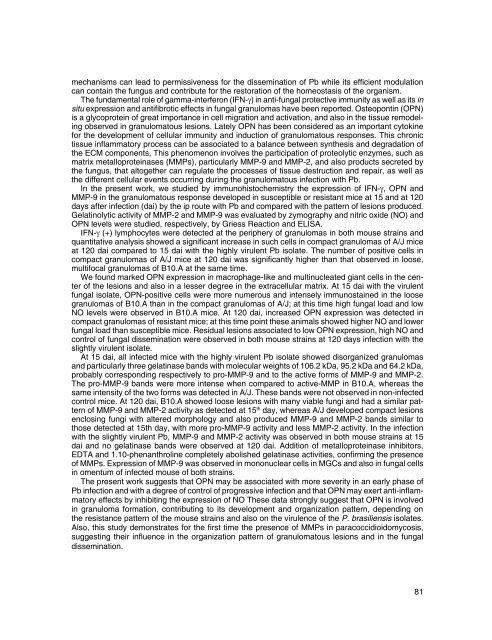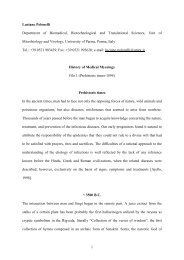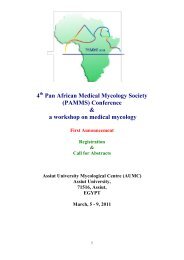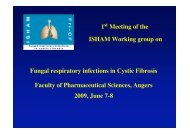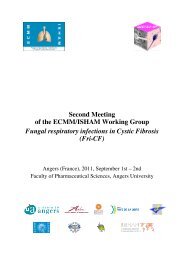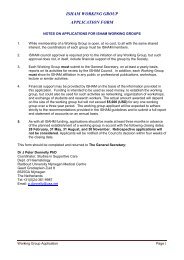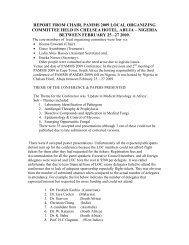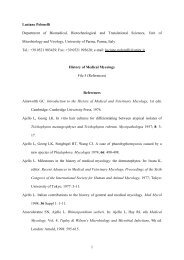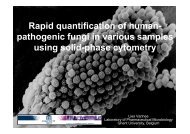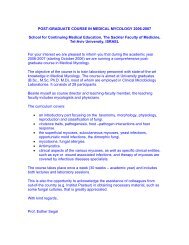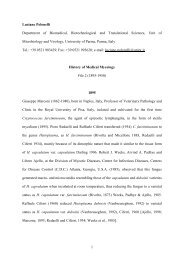Memoria CD.indd - ISHAM
Memoria CD.indd - ISHAM
Memoria CD.indd - ISHAM
Create successful ePaper yourself
Turn your PDF publications into a flip-book with our unique Google optimized e-Paper software.
mechanisms can lead to permissiveness for the dissemination of Pb while its efficient modulationcan contain the fungus and contribute for the restoration of the homeostasis of the organism.The fundamental role of gamma-interferon (IFN-γ) in anti-fungal protective immunity as well as its insitu expression and antifibrotic effects in fungal granulomas have been reported. Osteopontin (OPN)is a glycoprotein of great importance in cell migration and activation, and also in the tissue remodelingobserved in granulomatous lesions. Lately OPN has been considered as an important cytokinefor the development of cellular immunity and induction of granulomatous responses. This chronictissue inflammatory process can be associated to a balance between synthesis and degradation ofthe ECM components, This phenomenon involves the participation of proteolytic enzymes, such asmatrix metalloproteinases (MMPs), particularly MMP-9 and MMP-2, and also products secreted bythe fungus, that altogether can regulate the processes of tissue destruction and repair, as well asthe different cellular events occurring during the granulomatous infection with Pb.In the present work, we studied by immunohistochemistry the expression of IFN-γ, OPN andMMP-9 in the granulomatous response developed in susceptible or resistant mice at 15 and at 120days after infection (dai) by the ip route with Pb and compared with the pattern of lesions produced.Gelatinolytic activity of MMP-2 and MMP-9 was evaluated by zymography and nitric oxide (NO) andOPN levels were studied, respectively, by Griess Reaction and ELISA.IFN-γ (+) lymphocytes were detected at the periphery of granulomas in both mouse strains andquantitative analysis showed a significant increase in such cells in compact granulomas of A/J miceat 120 dai compared to 15 dai with the highly virulent Pb isolate. The number of positive cells incompact granulomas of A/J mice at 120 dai was significantly higher than that observed in loose,multifocal granulomas of B10.A at the same time.We found marked OPN expression in macrophage-like and multinucleated giant cells in the centerof the lesions and also in a lesser degree in the extracellular matrix. At 15 dai with the virulentfungal isolate, OPN-positive cells were more numerous and intensely immunostained in the loosegranulomas of B10.A than in the compact granulomas of A/J; at this time high fungal load and lowNO levels were observed in B10.A mice. At 120 dai, increased OPN expression was detected incompact granulomas of resistant mice; at this time point these animals showed higher NO and lowerfungal load than susceptible mice. Residual lesions associated to low OPN expression, high NO andcontrol of fungal dissemination were observed in both mouse strains at 120 days infection with theslightly virulent isolate.At 15 dai, all infected mice with the highly virulent Pb isolate showed disorganized granulomasand particularly three gelatinase bands with molecular weights of 106.2 kDa, 95.2 kDa and 64.2 kDa,probably corresponding respectively to pro-MMP-9 and to the active forms of MMP-9 and MMP-2.The pro-MMP-9 bands were more intense when compared to active-MMP in B10.A, whereas thesame intensity of the two forms was detected in A/J. These bands were not observed in non-infectedcontrol mice. At 120 dai, B10.A showed loose lesions with many viable fungi and had a similar patternof MMP-9 and MMP-2 activity as detected at 15 th day, whereas A/J developed compact lesionsenclosing fungi with altered morphology and also produced MMP-9 and MMP-2 bands similar tothose detected at 15th day, with more pro-MMP-9 activity and less MMP-2 activity. In the infectionwith the slightly virulent Pb, MMP-9 and MMP-2 activity was observed in both mouse strains at 15dai and no gelatinase bands were observed at 120 dai. Addition of metalloproteinase inhibitors,EDTA and 1.10-phenanthroline completely abolished gelatinase activities, confirming the presenceof MMPs. Expression of MMP-9 was observed in mononuclear cells in MGCs and also in fungal cellsin omentum of infected mouse of both strains.The present work suggests that OPN may be associated with more severity in an early phase ofPb infection and with a degree of control of progressive infection and that OPN may exert anti-inflammatoryeffects by inhibiting the expression of NO These data strongly suggest that OPN is involvedin granuloma formation, contributing to its development and organization pattern, depending onthe resistance pattern of the mouse strains and also on the virulence of the P. brasiliensis isolates.Also, this study demonstrates for the first time the presence of MMPs in paracoccidioidomycosis,suggesting their influence in the organization pattern of granulomatous lesions and in the fungaldissemination.81


